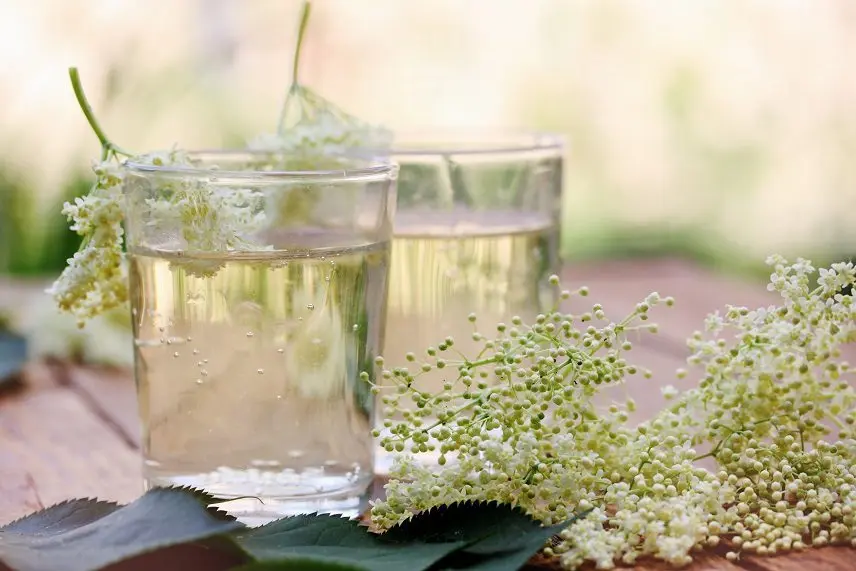Homemade elderflower kvass is a refreshing highly carbonated drink with a pronounced elderberry aroma and taste, as well as light floral notes. When using lemon instead of citric acid (more details in the recipe), citrus tones will appear. To call such a drink kvass can be a stretch. Rather, it is a kind of floral lemonade.
Theory
Fresh, fully blossomed inflorescences that have a pleasant smell are suitable for making elderberry kvass. It is better to harvest raw materials in dry sunny weather around noon, then the flowers contain a maximum of nectar. Immediately after the rain and on a cloudy day, the concentration of nectar is minimal, the drink will turn out worse. You can not collect inflorescences near roads and in other dusty places.

Fermentation is due to wild yeast that lives on the surface of the flowers, so the elderberry cannot be washed. You can play it safe and add raisin sourdough or store-bought wine yeast to the must, but then the fermentation period should be reduced to 2 days (in the recipe – 5 days), otherwise instead of kvass you will get elderberry champagne with a strength of 2-4% vol.
Citric acid creates the acidity required for fermentation and stabilizes the taste. If you take lemon juice and zest instead of pure acid, then citrus notes will appear in kvass. The amount of sugar can be increased by 500-600 g (additional add already before filling the bottles) or immediately reduced by 200-300 g.
Elder flower kvass recipe
Ingredients for 10 l:
- elderberry flowers – 150 g (about 40 pieces);
- water – 10 l;
- sugar – 1 kg + to taste;
- citric acid – 15 g (3 teaspoons) or 2 large lemons.
Preparation
1. Heat water in a saucepan to 40-45 °C, add sugar and citric acid (if used). Stir until all the sugar has dissolved, then remove the pan from the heat.
2. Separate elderberry flowers from petioles – rough green branches that give bitterness and a grassy aftertaste. Check the flowers for insects, shake off if necessary, but do not rinse with water so as not to wash off the yeast.
Rinse lemons (if used) in warm water, then wipe dry to remove preservative from peel. With a vegetable peeler or in any other way, remove the zest from the fruit – the yellow part of the skin without the white bitter pulp.
3. When the sugar syrup has cooled to a temperature below 30 ° C, pour it into a fermentation tank – an enamel pan or bucket. Add elderberry flowers, lemon zest and squeeze the juice from the fruits. Mix. There should be at least 10-15% free space left in the container for foam.
Attention! If the temperature of the syrup is above 30°C before the flowers are added, the yeast may die and fermentation will not start.
4. Cover the elderflower must with gauze or a thick cloth to protect it from insects. Transfer to a dark place with a stable temperature of 20-28 °C. Leave for 5 days. Be sure to stir 2 times a day, drowning the floating flowers in the liquid, otherwise the wort may turn sour. After 8-20 hours, fermentation should begin – foam and a slight sour smell will appear.
5. Remove the flowers, strain the future elderberry kvass through 2-3 layers of gauze. Taste the drink, optionally sweeten with sugar.
6. Pour kvass into bottles for storage. Be sure to leave at least 5-6 cm of free space to the lid so that there is room for carbon dioxide to accumulate. It is optimal to fill the bottles to three quarters of the volume. Close hermetically. If fermentation was weak, 3-4 unwashed raisins can be added to each bottle. Raisins contain wild wine yeast that activates fermentation.
7. Transfer the bottles to a refrigerator or cellar with a temperature of 3-10 °C. Leave for at least 3 days (preferably 5-10 days) for carbonation – saturation with carbon dioxide.
During the aging process, it is necessary to periodically control the bottles and, under excessive pressure (they were strongly inflated and became hard as a stone), bleed the gas through the cork, otherwise an explosion may occur.
The shelf life of homemade kvass from elder flowers is up to 3 months, but it is advisable to drink it within 30 days. During storage, a layer of sediment may appear on the bottom, this is normal.










